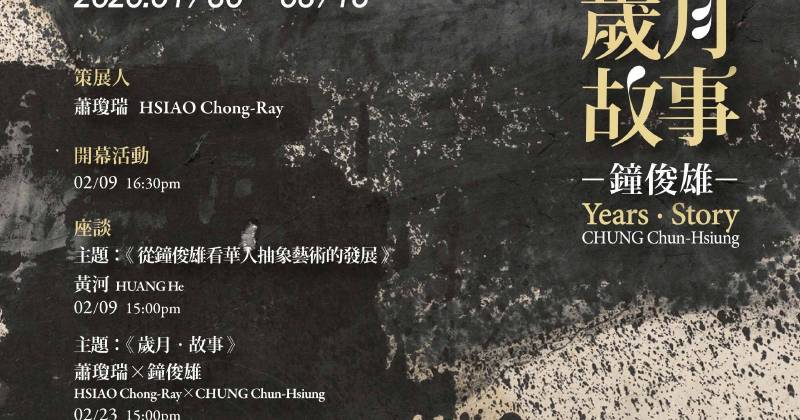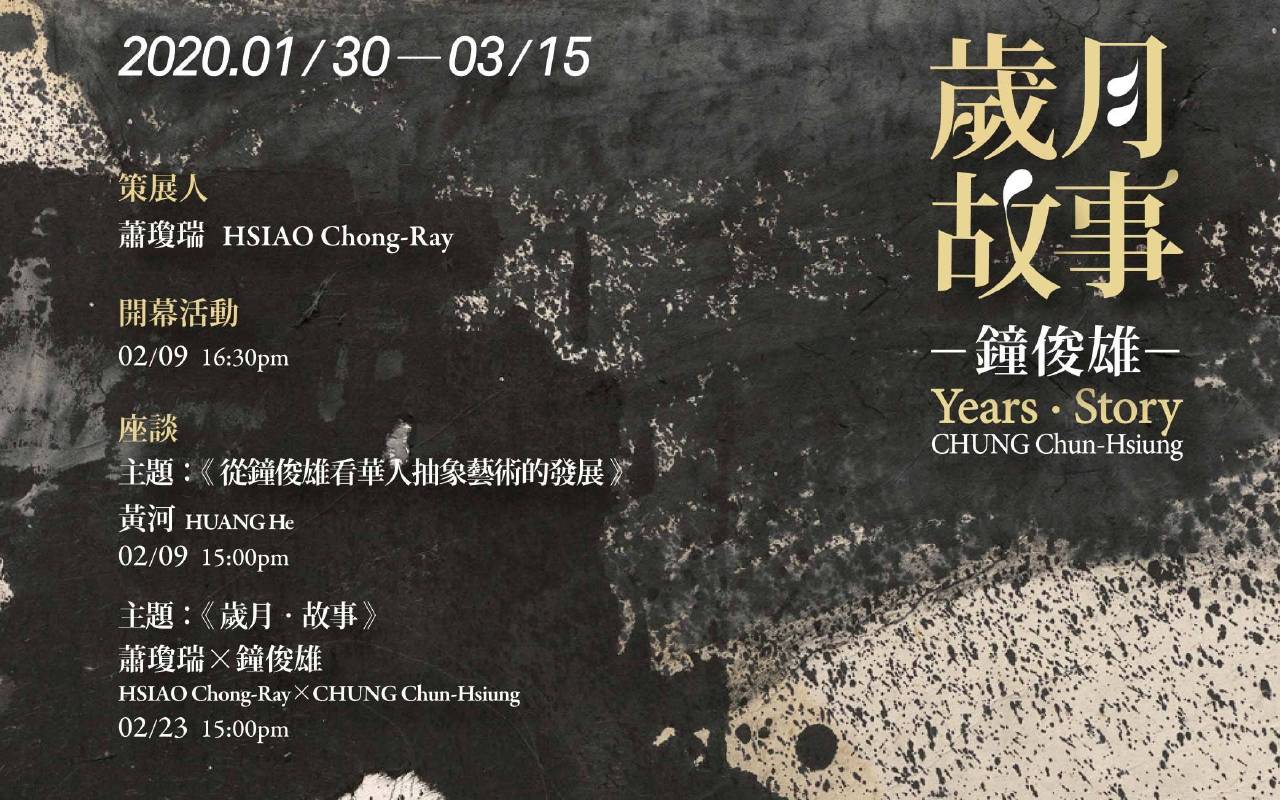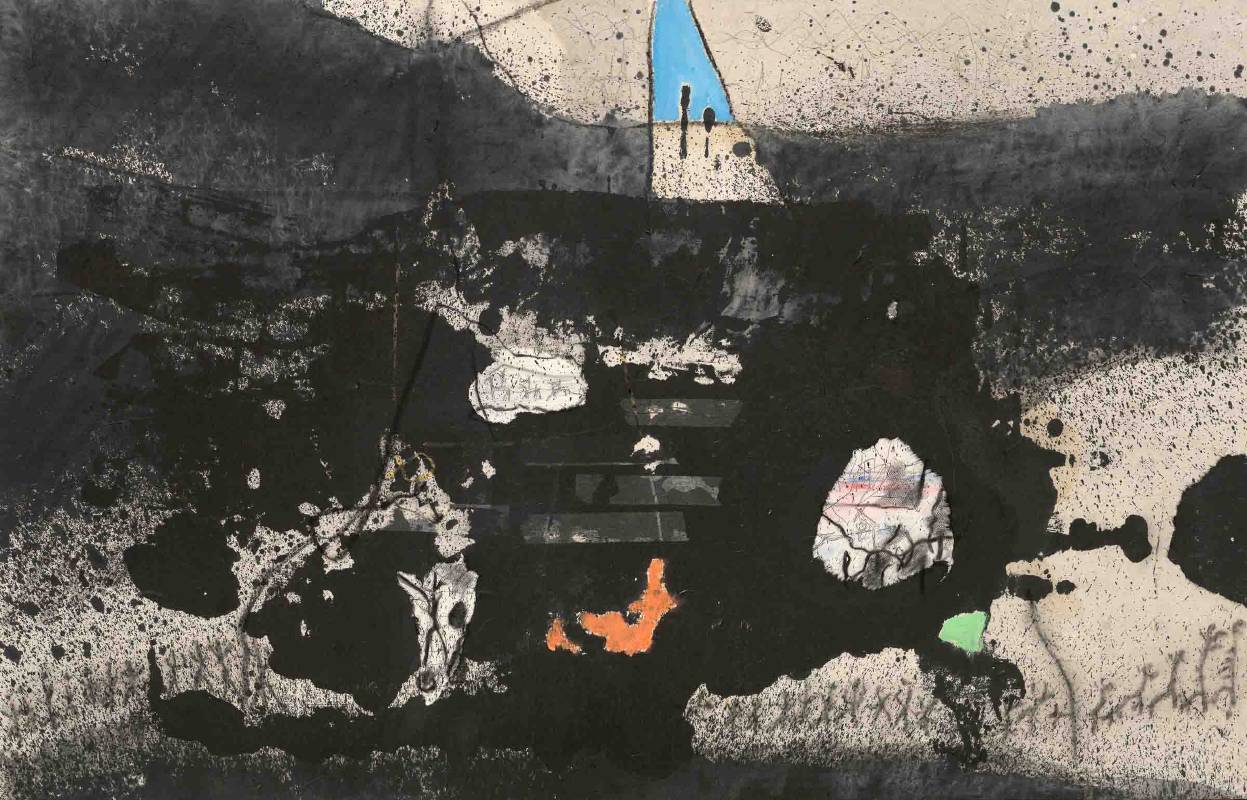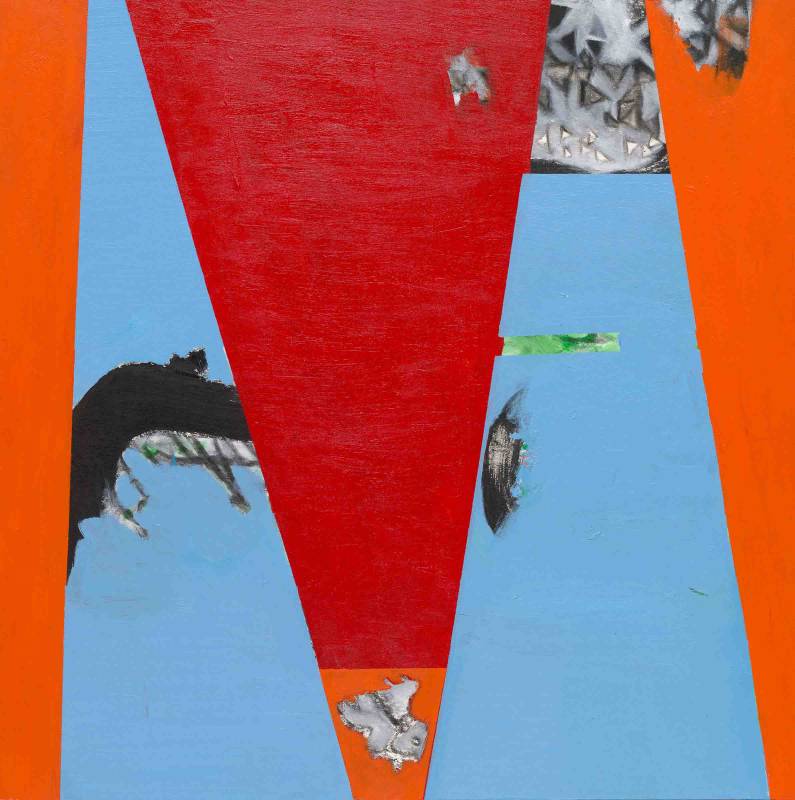采泥藝術
【歲月.故事—鐘俊雄個展 】 Years.Stories.CHUNG Chun-Hsiung

-
展期
日期:2020-01-30 ~ 2020-03-15
-
地點
台北市敬業一路128巷48號1樓
-
參展藝術家
鐘俊雄
-
歲月.故事—鐘俊雄個展
Years.Stories.CHUNG Chun-Hsiung
2020.01.30—03.15
采泥藝術
Chini Gallery, Taipei
策展人Curator:蕭瓊瑞 HSIAO Chong-Ray
開幕Opening:2020.02.09 16:30
講座I ForumI:2020.02.09 15:00
黃河 「從鐘俊雄看華人抽象藝術的發展」
講座II ForumII:2020.02.23 15:00
蕭瓊瑞 HSIAO Chong-Ray x 鐘俊雄 CHUNG Chun-Hsiung 「歲月‧故事」
「歲月.故事.鐘俊雄」為台灣資深藝術家鐘俊雄於采泥藝術舉辦的新春大展,由台灣知名藝術史家蕭瓊瑞擔任策展人。鐘俊雄(1939-),是被喻為台灣現代繪畫導師李仲生自台北南下彰化員林之後的第一批門生,他隨即受邀為「東方畫會」及「現代版畫會」的成員,共同推動戰後台灣1960年代最重要的現代繪畫運動。在1980年代,李氏的後期學生組成「現代眼畫會」,他也是重要的支持者,一手創作、一手寫評論,成為推動、延續大台中地區現代藝術的重要領導者,影響許多後進藝術家。
鐘俊雄的創作多元變化,時而水墨、時而油彩、時而拼貼、時而肌理,具實驗精神又富童稚趣味,他透過書法的筆捺、對稱的廟宇大門、剪紙技藝、過年節慶的意象等等尋找靈感,這些意象來自台灣土地記憶以及視覺色彩感受,用色雅致卻不張揚。鐘俊雄的藝術養分除了來自米羅、柯爾達之外,又加入了禪宗或佛學的理念與台灣鄉下的生活經驗,反思文化根源、生活感受以及如何在內容上的突破創新,作品在西方現代藝術的造型基礎上,結合東方用色與水墨技法,形塑其獨樹一格的抽象畫風。近期新作加入了更多的墨韻,透過形、色、黑、白的自由安排,構圖在揮灑中顯穩健,配色則從過往的豐富紛呈轉向內斂,作品帶有單純、童真的樸實溫暖,以平易近人的方式傳遞給觀眾。歲月只豐富了他的生命故事,未滅損他對生命歡唱的熱忱,本展希冀透過這些新作的展呈,賦予鐘俊雄創作思維全新詮釋的觀賞視角,端視台灣這位備受敬重的前輩藝術家,儘管已年過八十,仍以每天孜孜矻矻的創作,為其藝術生涯開創另一全新篇章。
For this coming Chinese New Year, Chini Gallery is pleased to present Years.Stories.CHUNG Chun-Hsiung, a solo exhibition featuring established and esteemed Taiwanese artist Chung Chun-Hsiang, curated by renowned Taiwanese art historian Hsiao Chong-Ray. Chung Chun-Hsiung (1939-) was one of the first group of students taught by Li Chun-Shan after the art master moved from Taipei to Changhua’s Yuanlin. He was soon invited to join Ton Fan Art Group and Modern Printmaking Association, both of which were the forces behind the most crucial modern painting movement in post-war Taiwan in the 1960s. In the 1980s, Li’s students from his later years founded Modern Eye Painting Association, for which Chung was an important supporter. Being both an artist and art critic, Chung is a pioneering figure in leading and advocating the modern art movement in the great Taichung region, whose influence has touched many later artists.
Chung’s work, ranging from ink, oil, collage to pure expression of texture, is diverse and multifaceted, displaying experimental qualities and child-like innocence. He finds his inspiration from calligraphic brushstrokes, symmetric temple gates, paper-cutting craft and festive imageries, which originate from native memories and colorful visual characterisitic of Taiwan; moreover, he expresses them through an elegantly refined and reserved palette. He also learns from Western art masters, such as Joan Miró and Alexander Calder, and incorporates Zen and Buddhist concepts as well as his experience of living in Taiwanese countryside into his work to reflect his cultural root, express his feelings about life and seek innovative breakthroughs in his creative content. He builds upon the formal foundation of Western modern art and combines Eastern colors and inking skills to formulate his unique abstract style. In his recent works, Chung adds more attributes and allure of ink painting. With the free arrangement of form, color, black and white, his composition seems unrestrained yet steady whereas the palette changes from being brightly colored to understated, conveying a sense of simple warmth informed by child-like innocence while capturing viewers’ attention in an approachable manner. The passing years have only enriched his life stories without diminishing his great zest for life. Chini Gallery hopes that this exhibition of the artist’s new works provides a fresh perspective to interpret and re-examine this highly respected artist. Though already in his eighties, the artist still works diligently and steadfastly to unfold a new chapter of his creative career.
✒ 藝評文章
歲月.故事.鐘俊雄
文/策展人 蕭瓊瑞
在台灣現代繪畫運動的發展歷程中,長居台中的鐘俊雄(1939-)是一位角色頗為多元的人物。他是李仲生1955年自台北南下彰化員林之後,第一批成為李氏門生,並隨即受邀成為「東方畫會」及「現代版畫會」的成員,共同推動戰後台灣1960年代最重要的現代繪畫運動。
而在1980年代,李氏的後期學生組成「現代眼畫會」,他也是重要的支持者,並一手創作、一手寫評論,成為推動、延續大台中地區現代藝術「教父級」的領導者,影響許多後進的藝術家。其既具實驗精神又富童稚趣味的作品,敘說著這位老頑童生命的歲月故事。
鐘俊雄是台中人,台中一中初中部畢業時,以優異成績保送高中部。父母依當時傳統的觀念,期待這個「很會唸書」的小孩,有天可以考上醫學院,將來當個人人尊敬的醫生。但這個「很會唸書」的小孩,在初中三年級那年,變成一個「很愛唸書」的小孩,閱讀了大量的文學作品,一頭栽進了文學的世界,接著便開始做起屬於「藝術家」的夢。
高中時期,他首先追隨前輩畫家,前往一些好山好水的景點寫生。學生們圈圍在老師畫架後面,努力學習取景、上色、用筆;如是幾年,年輕的鐘俊雄開始在心中產生困惑。自問:「繪畫是技術的訓練嗎?是大自然的重現嗎?為什麼達文西的蒙娜麗莎百看不厭?為什麼馬蒂斯的色彩那麼和諧?大藝術家的故事,不都是告訴我們:早期的學習階段之後,必須離開老師的羽翼,才能靠自己的才氣努力找到個人獨特面貌嗎?」
進入輔仁大學英語系那年(1957),也正是「東方畫會」推出首展的那年,鐘俊雄終於回到彰化,投入李仲生門下,展開對現代藝術的追求。
日後的鐘俊雄回憶說:「進入李仲生老師畫室,學到兩件創作最重要的事。第一是清楚世界美術史與中國美術史,知道什麼是藝術?古今中外大師是怎麼成功的;第二是個人的藝術成就完全靠自己,才氣再加上長久的努力、寬大的心胸、國際視野,才能找到自己的獨特風格。」(2013)
鐘俊雄在1964年同時受邀成為「東方畫會」與「現代版畫會」的會員,並參與展出;黃朝湖稱讚鐘氏的作品,是在超現實的基礎上,加入個人性格上的剛毅特質,極具自我的面貌與內涵;而隔年(1965)的展出,也獲得向邇的推崇,認為:他是最接近於詩的,既強調感覺,更能把所感帶入畫面。
事實上,鐘俊雄的創作,始終就是多元變化的。時而水墨、時而油彩、時而拼貼、時而肌理,他經常自問:「一幅畫除了形式之美以外,還能給些什麼?」因此,他經常跳脫純粹技巧的層次,企求有所表現。六、七○年代的作品,經常冠以文學性的標題,如:〈凝〉、〈蜥蜴的傳說〉、〈封閉的三色世
界〉、〈發紅發青發紫的機械世界〉、〈起飛淡入而消失的異域〉……等,這和他外文系的學院背景,顯然有關。此外,在畫面的形式上,往往也帶著兒童畫般的童趣與戲謔,杜布菲(Jean Dubuffet,1901-1985)的反文明、反既定美學、滿溢原始真情的作品,以及米羅(Joan Miró i Ferrà,1893-1983)、柯爾達(Alexander Calder,1893-1956)純真、幻想的超現實意境,都是他最欣賞的對象;但在這些養分之外,他又加入某些民俗或佛學的理念、符號,因此,一度在畫面上出現較多具象的圖像或符號,即使如此,仍有如〈1966-5B〉(1966)這樣的作品,在幾何的黃色方塊之外,完全以類似毛筆的粗細線條,進行潛意識的遊走;李仲生強調追求「東方」藝術的用心,顯然仍是這位「外文系」出身的學生用心探索的方向。
80年代之後,作品趨向單純,除了標題完全走向以「無標題」的代碼方式,畫面的符號也趨於非指向性的,甚至只有純粹的肌理表現,如:1985年的〈85-T〉;同時,也加入拼貼和水墨的趣味,如:1986年的〈86-H〉。不過,鐘俊雄的創作風格,到底無法以單一的面貌拘限,他的創作,帶著頑童的心理,一日數變,別人既無法預測,自我也不願拘限;同樣是80年代,相對於前提二作,1987年又有〈87-5G〉這樣的作品,偏向內心的探討。他曾說:「我的創作,試圖追求生命中各種可能;我每天面對畫布時,就像蛇以它的腹部在粗礪沙灘間爬行,東彎西拐,探索沒人到過的未知之路。」(2013)果然,90年代之後,又有如〈年年有餘〉 (1993)這樣的作品,在紅、黑對比的強烈色彩中,映現出一盤白瓷碟上的雙魚,後有同樣圖形的反覆出現,甚至加入「年年有餘」、「歲歲平安」的對聯的,充滿年節的喜樂之情。而新世代之後,既有〈2011-5A〉(2011)、〈十字路聯想〉 (2014)這樣的強烈色彩、乃至帶著幾何圖案造型的作品,也有〈2012-2A〉(2012)、〈2012-2B〉(2012)這類淡雅、禪思的創作,長幅立軸的尺寸、黑、灰、淡黃、留白的色彩,仍是這位老頑童哲學家的一貫作為,不為形拘、不受限制。
鐘俊雄的多才多藝,讓他的表現領域複雜多樣,除油彩、版畫之外,他更早在1967年便加入「中華民國雕塑協會」;初期以木雕為主,帶著一些禪意的抽象表現,之後,以鐵雕為主,90年代創作大量作品,在「百分之一公共藝術」政策實施後,他也多次參與公共藝術的創作。
鐘俊雄一手畫畫、雕刻,又一手寫藝評,他精淬的評論,讓他逐漸成為中部地區現代藝壇的發言人,甚至是年輕藝術家的導師,隱隱延續著恩師李仲生當年的志業;加上他的頑童性格,與人為善,也成為許多老畫家倚賴的關照者。
新世紀的來臨,鐘俊雄已然從頑童,走入「老頑童」,而且是一個備受敬重、語出智慧的老頑童,許多的邀展不斷,也促發了另一波的創作熱情,回到文學性的標題,標示自我成熟、舒緩的心境。
2013年年底,在台中中友百貨「源.生命──鐘俊雄當代藝術展」的畫冊序言中,他說:「經過七十五年人生,生老病死已了然於胸,我想用無作用的自性表達我活在台灣、地球的所有愛恨情愁。我愈老愈明白:愈簡單,愈難表現;愈抽象的內心感悟,越難說清楚。我努力追求在造型架構(理性)中自性的本心──生命之源。」
相隔七年後的2020年,是他82歲的大壽之年,采泥藝術為他推出的新作展,呈顯這位不老騎士的青春心靈。歲月只有豐富他生命故事的豐采,未曾滅損他對生命歡唱的熱忱。鐘俊雄用他的彩筆,邀請朋友們共同暢飲生命的醇酒。■
Years.Stories.Chung Chun-Hsiung
Text / Hsiao Chong-Ray, Curator
Throughout the development of Taiwan’s modern painting movement, Taichung-based artist Chung Chun-Hsiung (1939-) has played diverse and crucial roles. After Chung became one of the first group of students taught by Li Chun-Shan after the art master moved from Taipei to Changhua’s Yuanlin in 1955, he was soon invited to join Ton Fan Art Group and Modern Printmaking Association, and joined the forces that facilitated the most crucial modern painting movement in post-war Taiwan in the 1960s.
In the 1980s, Li’s students from his later years founded Modern Eye Painting Association, for which Chung was an important supporter. Being both an artist and art critic, Chung is a “godfather-like” figure in leading and advocating the modern art movement in the great Taichung region, whose influence has touched many later artists. Chung’s work, which is informed with experimental qualities and child-like innocence, seems to tell this urchin-like senior artist’s youthful spirit and his life stories.
Born and raised in Taichung, Chung was recommended for admission into the senior high school department of Taichung First Senior High School when he graduated with excellent grades from the school’s junior high school department. Due to their conservative views, his parents naturally expected that this child, who were good at getting high grades, could one day get into the medical school and became an esteemed doctor in the future. However, this student who always got good grades became “a lover of good books” in the ninth grade. Having read an extensive amount of literary works, he dived into the world of literature and started dreaming about becoming an “artist.”
During his high school years, Chung first followed the footsteps of established artists to do outdoor sketches of scenic landscape. The students would always gather behind their painter teacher in front of the easel, learning about how to select the scene, apply colors and use of brush. After several years, the young artist felt confused and asked himself: “Is painting only a training of techniques or the representation of nature? Why can one look at Da Vinci’s Mona Lisa and not feel bored? How can Matisse create such a colorful harmony? The stories of these art masters always tell us one thing: one must take off from underneath the teacher’s wing after the initial learning stage, and rely on one’s talents to diligently discover one’s unique art.”
The year (1957) that Chung entered Fu Jen University’s Department of English Language and Literature coincided with the year of Ton Fan Art Group’s first art exhibition. Chung eventually returned to Changhua, where he became Li Chun-Shan’s student and embarked on his quest of modern art.
Reminiscing the past, Chung stated that “there were two most important things about artistic creation I
learned when studying at Li Chun-Shan’s art studio. The first was getting a perspicuous understanding about world art history and Chinese art history, which gave me a clear idea of what art was and how Western and Asian art masters achieved their success. The second was the realization that one’s artistic achievement depended fully on oneself. Only talents, steadfast efforts, open-mindedness and international vision could enable one to formulate a unique style.” (2013)
In 1964, Chung was invited to join both Ton Fan Art Group and Modern Printmaking Association, and participated in their exhibitions. Huang Chao-Hu once praised Chung’s work, stating that Chung added the perseverance in his personality to a surreal foundation and revealed a highly individualistic expression and meaning. In the exhibition launched the next year (1965), Xiang Erh also complimented on Chung’s work, saying that his work was the most poetic, not only emphasizing on sensibility but also visualizing it.
In truth, Chung’s work has always been diverse and multifaceted, ranging from ink, oil, collage to pure expression of texture. He often asks himself, “what else can a painting offer besides formal beauty?” Therefore, he constantly looks for means to move beyond techniques and seek alternative expression. His works from the 60s and 70s often possessed literary titles, such as Coagulation, Legend of Lizards, Enclosed Tricolored World, A Mechanical World of Red, Green and Purple, Taking Flight into the Disappearing Strange Land, etc. This obviously beckons at a relation to his learning of foreign language and literature. Additionally, the form of paintings created by Chung often exudes a child-like innocence and playfulness. He draws inspiration from artists he admires, such as the primitive, genuine works by Jean Dubuffet (1901-1985) that rebel against civilization and existing aesthetics as well as the pure, fantastic, surreal images created by Joan Miró i Ferrà (1893-1983) and Alexander Calder (1893-1956). Moreover, he also incorporates certain folk or Buddhist concepts and symbolism into these Western artistic influences. Therefore, his works sometimes contain more concrete images or symbols. Even so, there are still works like 1966-5B (1966), in which the delineation of the subconscious with thick and thin calligraphic lines is combined with geometric yellow blocks. Li Chun-Shan’s emphasis on pursuing the “Eastern” art has clearly pointed out a crucial direction of steadfast exploration for this student coming from a background of foreign language and literature.
After the 80s, Chung simplified his works and only named them “Untitled” with the addition of letters and codes. In the meantime, the symbols in his works also became non-signifying, and at times pure depiction of texture, such as 85-T created in 1985. Also, he began adding collage and ink expression into his work, for example, 86-H painted in 1986. However, Chung’s work still defied generalization and could not be contained within one single genre. His style exuded a sense of mischievousness and remains unpredictable with its various changes, as the artist himself refused to limit his art. Contrasting to the aforesaid two works created in the 80s, he also created 87-5G in 1987, which visualized his inner exploration. He once stated that “I tried to seek out all the possibilities in life through my work. When facing the canvas every day, it would slither through the sandy beach with its belly, zigzagging to explore the untrodden paths.” (2013) In the 90s, unsurprisingly, he also created works like Surplus Year After Year (1993), in which he portrayed two fish on a white porcelain dish amid vividly contrasting red and black, with similar images repeatedly dotting the background and a festive couplet – “surplus year after year” (年年有餘) and
“peacefulness year after year” (歲歲平安) – that conveyed the joy of Chinese New Year. After the new millennium, Chung created works such as 2011-5A (2011) and Association of Cross Road (2014), which revealed a combination of strongly vibrant colors and geometric shapes and forms. On the other hand, he also painted elegant and Zen-like paintings in the form of long vertical scrolls with black, gray, light yellow and blank space, such as 2012-2A and 2012-2B (2012). This mischievous yet philosophical artist has remained consistent in art-making, unbounded and unhindered by artistic forms and restraints.
Chung’s versatility has enabled him to engage in diverse and complex creative endeavors. In addition to oil painting and printmaking, he had joined the Sculpture Association of Taiwan, R.O.C. as early as 1967. At first, he mainly created wooden sculptures with an abstract, Zen expression. Later, he moved on to iron sculptures and created a large body of works in the 90s. After the implementation of the “percent-for-art” policy, he also created several public art projects.
While creating painting and sculpture, Chung was also an art critic. His insightful criticism and reviews gradually made him the spokesman of the modern art scene in central Taiwan. He has been even considered a mentor by the young generation of artists, implicitly continuing the lifelong mission of his own mentor, Li Chun-Shan. His mischievous, child-like personality allows him to maintain a harmonious relationship with others and makes him someone that many senior artists could rely on.
As the new century arrived, Chung now enters a new stage in life, in which he can be considered a “senior urchin”—a highly respected, wise one. He has received constant exhibition invitations that fuel him with a new wave of creative energy. He again starts giving literary titles to his work, which reveal a sense of maturity and inner composure.
In the preface to the exhibition catalogue of his exhibition at Taichung’s Chungyo Department Store at the end of 2013, entitled Origin.Life—Chung Chun-Hsiung Contemporary Art Exhibition, he makes the following statement: “having lived for seventy-five years, I have come to terms with the natural cycle of life. I hope to express all my feelings of living in Taiwan and on Earth with the unchanging nature of the self. As I get older, one thing has become clearer to me: the simpler things are harder to delineate; and the abstract inner realization is more challenging to make explicit. Among form and structure (rationality), I strive to pursue the original nature of the self—the origin of life.”
In 2020, seven years after the Taichung exhibition and the year to celebrate his eighty-second birthday, Chini Gallery is presenting an exhibition featuring Chung new works, which validates this senior artist’s youthful mind and spirit. The passing years have only enriched his life stories without even diminishing a bit of his great zest for life. With his colorful brush, the artist still invites all his friends to drink up this mellow cup of wine called life.
推薦藝術家
view all推薦展覽
view all采泥藝術
【生命之花─四季 陳承衛個展】“Blossoms of Life - The Seasons” CHEN Cheng Wei Solo Exhibition
日期:2023-01-14 ~ 2023-03-05|台灣,台北市
采泥藝術
【天 問 ─ 董承濂 x 張永達】Re-sensing the Cosmos ─Nick DONG x CHANG Yung-Ta
日期:2022-08-20 ~ 2022-10-02|台灣,台北市




